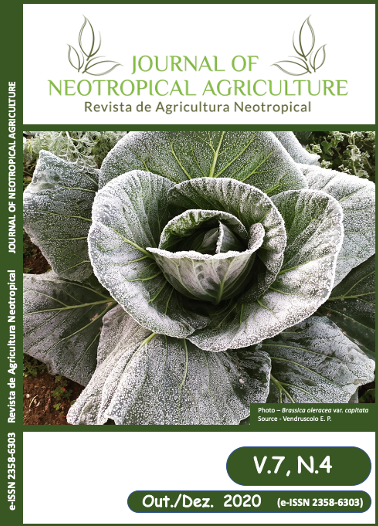APPLICATION OF DIFFERENT SOURCES AND DOSES OF BORON IN THE CORN CROP
DOI:
https://doi.org/10.32404/rean.v7i4.4464Abstract
One of the main problems faced in corn cultivation, especially in Cerrado regions, is the deficiency of micronutrients. Among the micronutrients essential for the development of plants, boron (B) stands out for participating in a series of physiological processes. Based on this, the present work aimed to evaluate the performance of corn under fertilization with different sources and doses of boron. The randomized block design in a 4x3 factorial scheme was used. Four boron doses (0, 1, 2, and 3 kg ha-1) and three nutrient sources (boric acid, borax, and ulexite), applied in topdressing, were evaluated. Plant height (cm), stem diameter (mm), first ear insertion height (m), ear length (cm), ear diameter (mm), number of rows per ear, number of grains per row, 1000-grain weight (g), and grain yield (kg ha-1) were evaluated. It was concluded that the boron sources and doses used did not influence the results of plant height, first ear insertion height, number of rows per ear, and grain yield. The three doses evaluated provided increases in stem diameter, with a dose of 2.08 kg ha-1 being the one with the highest average. The application of borax and ulexite results in higher values of ear diameter, number of grains per row, and 1000-grain weight. The dose of 1.74 kg ha-1 of boron provides the highest 1000-grain weight.References
(I) CONAB. Companhia Nacional de Abastecimento, 2019. Acompanhamento da safra brasileira de grãos. Volume 6 - Safra 2018/19 - Décimo segundo levantamento, setembro 2019. Brasília, CONAB, 121 p.
(II) CONAB. Companhia Nacional de Abastecimento, 2018. Perspectivas para a agropecuária. Volume 6 - Safra 2018/19. Brasília, CONAB, 112 p.
(III) Dourado Neto, D., Favarin, J.L., Manfron, P.A., Pilau, F.G., Soares, M.A., Bonecarrère, R.A.G., Ohse, S., 2004. Efeito de boro e nitrogênio na cultura do milho. Insula, 33(1), 51-67.
(IV) Ferreira, M.M.M., 2012. Sintomas de deficiência de macro e micronutrientes de plantas de milho híbrido BRS 1010. Revista Agro@mbiente Online, 6(1), 74-83. DOI: http://dx.doi.org/10.18227/1982-8470ragro.v6i1.569.
(V) Galindo, F.S., Teixeira Filho, M.C.M., Buzetti, S., Boleta, E.H.M., Rodrigues, W.L., Rosa, A.R.M., 2018. the application forms and doses of boron affect wheat crops? Revista Brasileira de Engenharia Agrícola e Ambiental, 22(9), 597-603. DOI: http://dx.doi.org/10.1590/1807-1929/agriambi.v22n9p597-603.
(VI) Jamami, N., Büll, L.T., Corrêa, J.C., Rodrigues, J.D., 2006. Resposta da cultura do milho (Zea mays L.) à aplicação de boro e zinco no solo. Acta Scientiarum Agronomy, 28(1), 99-105. DOI: doi.org/10.4025/actasciagron.v28i1.1683.
(VII) Kappes, C., Gollo, A.L., Carvalho, M.A.C., 2008. Doses e épocas de aplicação foliar de boro nas características agronômicas e na qualidade de sementes de soja. Scientia Agraria, 9(3), 291-297. DOI: dx.doi.org/10.5380/rsa.v9i3.11563.
(VIII) Nogueira, L.M., Teixeira Filho, M.C.M., Megda, M.M., Galindo, F.S., Buzetti, S., Alves, C.J., 2019. Corn nutrition and yield as a function of boron rates and zinc fertilization. Semina: Ciências Agrárias, 40(6), 2545-2560. DOI: dx.doi.org/10.5433/1679-0359.2019v40n6p2545.
(IX) Santos Junior, J.A., Gheyi, H.R., Dias, N.S., Soares, F.A.L., Nobre, R.G., 2011. Doses de boro e água residuária na produção de girassol. Revista Ciência Agronômica, 42(4), 857-864.
(X) Silva, I.F., Barbosa, A.M., Tiritan, C.S., Catuchi, T.A., 2014. Adubação boratada na cultura do arroz em solos de Cerrado de baixa fertilidade. Colloquium Agrariae, 10(especial), 1-8. DOI: 10.5747/ca.2014.v10.nesp.000130.
(XI) Songkhum, P., Wuttikhun, T., Chanlek, N., Khemthong, P., Laohhasurayotin, K., 2018. Controlled release studies of boron and zinc from layered double hydroxides as the micronutrient hosts for agricultural application. Applied Clay Science, 152, 311-322. DOI: 10.1016/j.clay.2017.11.028.
(XII) Soomro, Z.H., Baloch, P.A., Gandhai, A.W., 2011. Comparative effects of foliar and soil applied boro non growth and fodder yield of maize. Pakistan Journal of Agricultural Sciences, 27(1), 18-26.
(XIII) Tavares, L.C., Oliveira, S., Lemes, L.S., Meneghello, G.E., 2015. Qualidade fisiológica e crescimento inicial de sementes de milho recobertas com micronutrientes. Revista de Agricultura, 90(2), 156-167.
Downloads
Published
How to Cite
Issue
Section
License
The authors retain the rights to the manuscripts and, therefore, are free to share, copy, distribute, perform and publicly communicate the work under the following conditions:
Acknowledge work credits in the manner specified by the author or licensor (but not in a way that suggests that you have their support or that they support their use of their work).
REVISTA DE AGRICULTURA NEOTROPICAL (ISSN 2358-6303) is under license https://creativecommons.org/licenses/by/4.0/
The State University of Mato Grosso do Sul, Sustainable Development Center of Bolsão Sul-Mato-grossense (CEDESU), of the University Unit of Cassilândia (UUC), preserves the patrimonial rights (copyright) of the published works and favors and allows their reuse under the license as mentioned above.
------------
The journal reserves the right to make normative, orthographic, and grammatical alterations in the originals, to maintain the cult standard of the language, respecting, however, the style of the authors.
Final proofs will be sent to the authors.
Published works become the property of the journal. The opinions expressed by the authors of the manuscripts are their sole responsibility.

